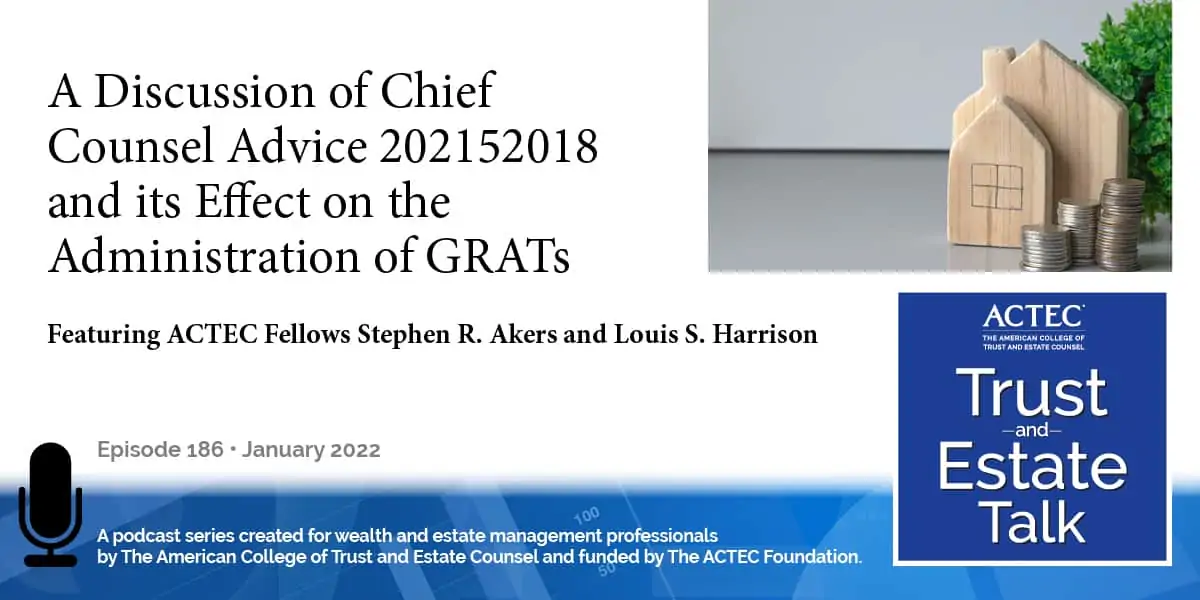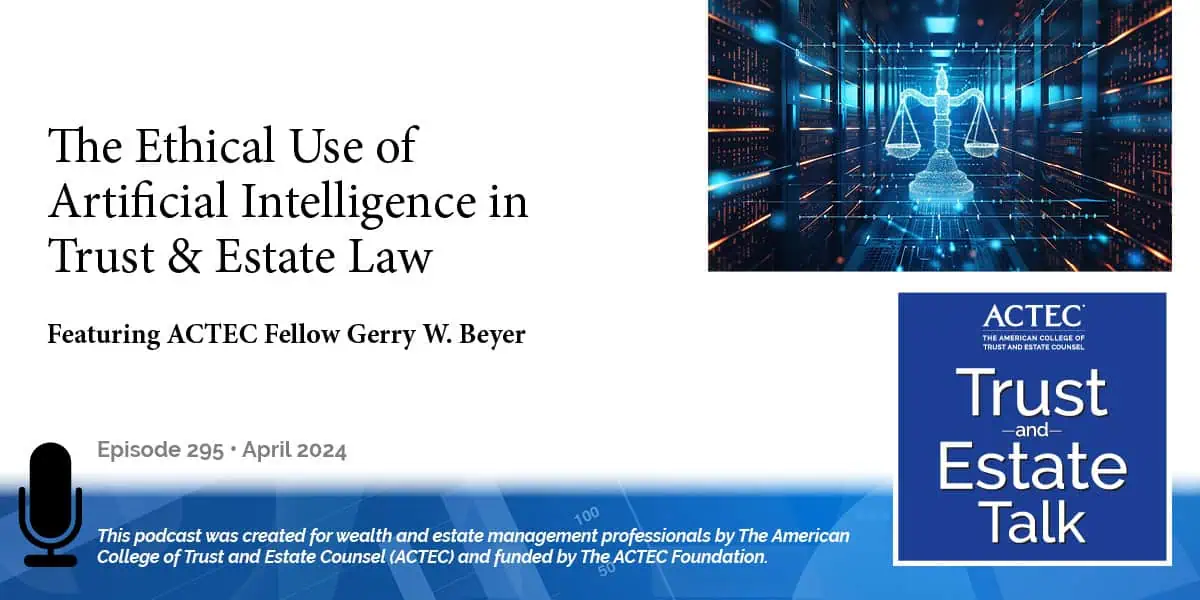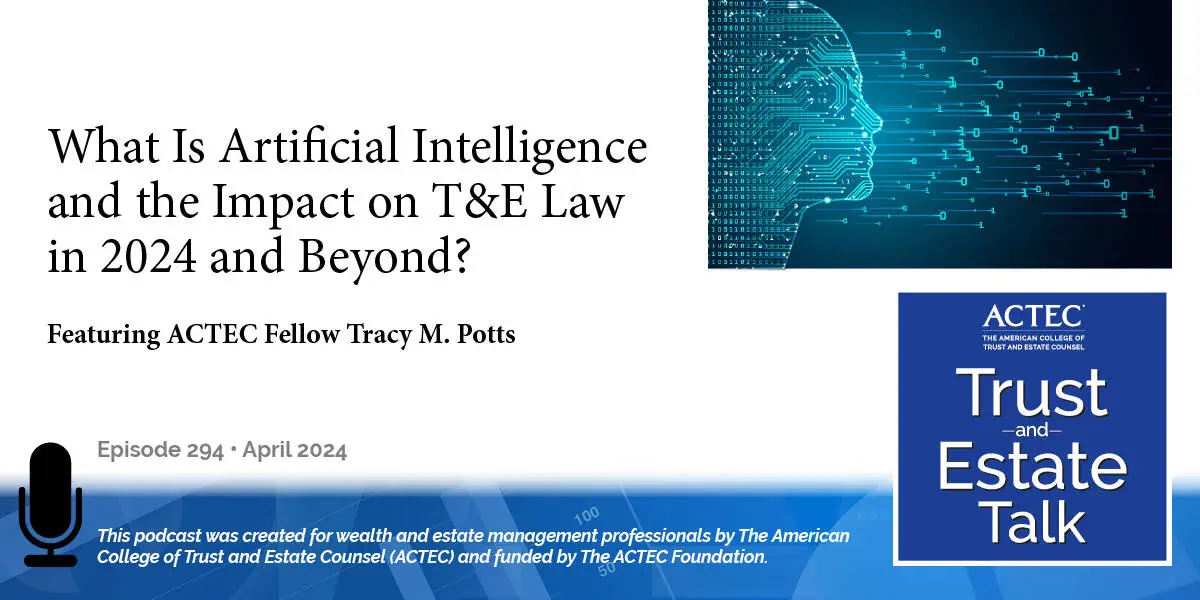A Discussion of Chief Counsel Advice 202152018 and its Effect on the Administration of GRATs

“A Discussion of Chief Counsel Advice 202152018 and its Effect on the Administration of GRATs,” that’s the subject of today’s ACTEC Trust and Estate Talk.
Transcript/Show Notes
This is Travis Hayes, ACTEC Fellow from Naples, Florida. In Chief Counsel Advice 202152018, the IRS issued a very surprising ruling about GRATs. The IRS plowed new ground in taking an unprecedented and very harsh position on GRATs. This ruling seems to be contrary to their own regulation. Today, ACTEC Fellows Steve Akers of Dallas, Texas and Lou Harrison of Chicago, Illinois will discuss this recently issued IRS ruling. Welcome to Steve and Lou.
The Background of Final Position of CCA 202152018
Thank you, Travis. In CCA 202152018, the donor who was the founder of a very successful company, transferred shares of the company to a two-year Grantor Retained Annuity Trust. We refer to that as a GRAT. As is very often done with GRATs, the annuity amounts were specified in terms of a percentage of the initial fair market value of the trust. In determining what that initial fair market value was, to determine the annuity payments of each of those two years, they used an appraisal that was dated seven months prior to the time of the transfer into the GRAT. The appraisal actually had been done for a nonqualified deferred compensation plan arrangement.
In the meantime, after that appraisal had been done seven months earlier, the donor began merger discussions with other people about the possibility of buying the company. And he actually had four offers in hand at the time that the transfer was made into the GRAT. Even so, they used that seven-month prior appraisal amount. Well, after the transfer into the GRAT, there were some updates on the offers. Six months later, bottom line, they accepted one of the offers that came in at three times the value that was used for the GRAT purpose of determining those annuity amounts.
Another interesting little fact, right before the closing on the tender offer, the donor also made a transfer into a Charitable Remainder Trust and, for that purpose, used the actual tender offer price for determining the transfer into the Charitable Remainder Trust and, therefore, the amount of the income tax deduction. Two issues arose in this Chief Counsel Advice. And keep in mind what a Chief Counsel Advice is: that’s just advice from the IRS Chief Counsel from the attorneys to the agents of a litigating position. It is just an IRS position – an unpublished, unofficial position. Two issues: the first was that the value should take into consideration a pending merger and the discussions of that. This was very similar to a ruling that we got in 2019, CCA 201939002, where the IRS took a very similar position of an ongoing merger that you ought to take that into account because a hypothetical buyer would know about that and would do so. And indeed, that part of the Chief Counsel Advice is almost, word for word, what the 2019 one was, except that, in this one they added the phrase, “And thereby casts more than just doubt on the bona fide to the transfer to the GRAT.”
The CCA went on to look by analogy to the Atkinson Case, which was a charitable remainder annuity trust case. One of the requirements of a Charitable Remainder Annuity Trust is that there must be at least 5% annual distributions. Although, apparently, that CRAT was created appropriately, they never actually made any annuity payments. And so, the court concluded that, because of this operational failure, no deduction at all, was permitted for the CRAT in the Atkinson Case.
The CCA used that to rationalize that this would not be treated as a qualified annuity interest. And therefore, the value of the retained annuities was zero. So, the donor made a gift equal to the full value transferred into that CRAT. The conclusion in the CCA is that the operational effect of deliberately using an undervalued appraisal is to artificially depress the required annual annuity.
“Thus, in the present case, the artificial annuity to be paid was 34 cents on the dollar instead of the required amount, allowing the trustee to hold back tens of millions of dollars. The cascading effect produced a windfall to the remaindermen. Accordingly, because of this operational failure, the donor did not retain a qualified annuity interest under § 2702.”
Discussion of Current and Future Impact
I understand the IRS’ reaction. One of the features we like best about the GRATs is that the regulations tell us we can have this “savings feature” in it. We can say the annuity amount is the percentage of the finally determined gift tax value. So, if it’s finally determined to be a different value, it just automatically adjusts the annuity amount, and the remainder value may go from $10 to $11. It’s just wonderful. But the IRS’ concern is for cheaters, unscrupulous taxpayers. I think they’re concerned with defined value clauses, generally, that someone would use just an outrageously unreasonably low appraisal.
If they don’t get caught, they got by with it. If they do get caught, they just adjust it and life goes on. And so, the IRS, in this case, took the totally unprecedented position – they’ve never done this before – to say that using an improper appraisal of the hard-to-value amount of the annuity payments causes the annuity interest not to be a qualified interest and to be valued at zero. So, a huge gift was made when the GRAT was created. Okay, I understand the IRS concern, BUT. Lou, let me just pitch it to you at that point.
Okay. Well, Steve, I don’t want to be the practitioner calling the client indicating that the client’s made a 100% taxable gift. And I look at these CCAs and I think the sole purpose of them is to terrify me, and this one definitely terrifies me. It feels like the old Revenue Ruling 79-353 which, when it came out, seemed absolutely incorrect. That revenue ruling said that an ability of a grantor to remove a corporate trustee and replace that corporate trustee with another corporate trustee was a retained right to designate the assets under 2036 (a)1 – or 2036(a)2, rather.
And that revenue ruling sat out there and also terrified me and other practitioners for a long time, until, ultimately, the Wall Case invalidated it, essentially, and then the IRS was forced to revoke that revenue ruling. I think, ultimately, if this type of case gets to a court, if they (the IRS) take this position, I think the court invalidates it (the IRS position). But we don’t want to be there (in court having to invalidate the Service’s position), right? So, if we don’t want to be there, what is it we’re going to do knowing that CCA’s out there and that an audit could, theoretically, invoke the reasoning in the CCA, i.e., if we violate the facts, we have 100% taxable gift with a GRAT.
Ideas on Steps to Take
Well, number one, the global for all of us is: let’s stop getting too cute with transactions. Let’s go back to the trite phrase and recognize that pigs get larger and hogs get slaughtered. And the fact pattern in this CCA is definitely a hog fact pattern. We don’t want to be there. So, when you have difficult-to-value assets – and in particular — let’s just talk about GRATs, although the reasoning of this CCA could apply to Wandry formulas in sales, as well, and Wandry formulas in gifts (Joanne Wandry v. Commissioner, T.C. Memo. 2012-88). But let’s say we have GRATs.
When you have difficult-to-value assets and you may have a corporate transaction that’s going to occur after the GRAT setup, at a minimum, have your valuation as of the date of the GRAT. That is, have the valuation be that date. It can be done after the GRAT’s in place, but have it be that date based on facts and knowledge that existed on that date. Facts and knowledge in this CCA would include the understanding that there have been some offers out there. Have your valuation expert take that into account. Do not ignore that. And, if you can take that step, you can essentially avoid the concept and the reasoning in the CCA. So, we have to be, again, a little less cute with some of the valuations that are going on and a little more timely (accurate valuation date) in terms of the valuation itself. This valuation, in this CCA, was done months before the actual GRAT was put in place, and that’s the one that was used. So, that’s my major takeaway from this. And, again, we’re going to have to see, ultimately, what the court would do if this reasoning is applied to future GRATs or sales. Steve, you want to add to that, please?
Lou, I agree that the CCAs typically come about in an actual case and the agent will submit an issue to the Chief Counsel Office of what position to take. And so, hopefully, this actual case will come to a different conclusion. The concern of this case is that it basically puts all GRATs involving hard-to-value assets at risk. If you use an appraisal that ends up being the wrong value, do you risk that the full amount transferred to the GRAT is a gift? The whole point of – the major advantage of GRATs is that we can shift future appreciation, but not make a huge gift upfront.
Well, that just puts every GRAT involving a hard-to-value asset under the rationale of this CCA at risk of having a large gift. And, it is just totally egregious, particularly in light of the fact that the regulations not only allow us to define the annuity amount in terms of the finally determined gift tax value going in, but it also has a provision that the instrument can say that: “In the event of an incorrect determination of the value, this is what you do after the fact.” (Regulation §25.2702-3(b)(1)(ii)(B) & §25.2702-3(b)(2).)
And so, the IRS approach of saying that it’s using the Atkinson Case to say an inaccurate appraisal just totally blows up the GRAT, resulting in the full gift amount going in — is just really an outrageous position. And I agree that, I certainly hope, the case doesn’t go that way. But, I certainly also agree with Lou. You have very good ideas on steps to take so that we don’t have the IRS viewing our situation as an abusive cheater sort of situation, and not to take this sort of position. But, this is a very surprising result from this CCA and troubling, in the event that it should be upheld by the courts.
I completely agree.
Thank you, Steve and Lou, for discussing this recently issued IRS ruling and its effect on the administration of GRATs holding hard-to-value assets.
If you have ideas for a future ACTEC Trust & Estate Talk topics, please contact us at ACTECpodcast@ACTEC.org.
Latest ACTEC Trust and Estate Talk Podcasts

The Ethical Use of Artificial Intelligence in Trust & Estate Law
A law professor offers insights into the risks, rewards, duties and ethical considerations of lawyers using AI in their T&E practices.

What Is Artificial Intelligence and the Impact on T&E Law in 2024 and Beyond?
A primer on the types and uses of AI, then a deeper dive into the impact on trust and estate law from types to applications to ethical considerations.

The IRS Ruling on Modifying a Grantor Trust
Explore the gift tax implications for trust beneficiaries modifying grantor trusts in IRS CCA 202352018, with nuanced analysis and estate planning insights.

